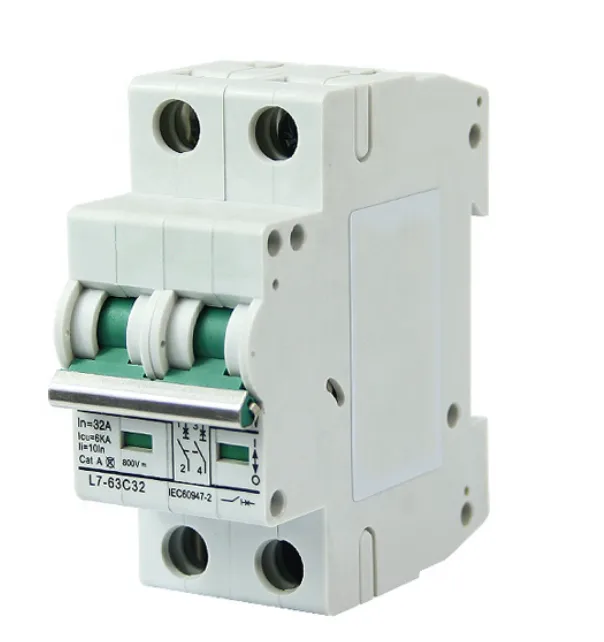Introducción
Selecting the right DC circuit breaker isn’t just about matching amperage ratings. Unlike AC breakers that benefit from natural zero-crossing points, DC circuit breakers face unique challenges with arc extinction and continuous current flow. Whether you’re protecting solar panel installations, automotive circuits, or industrial DC systems, understanding these critical differences can prevent equipment damage and ensure safety compliance.
This comprehensive guide covers the essential factors for DC circuit breaker selection, from voltage ratings to application-specific requirements.

Why DC Circuit Breakers Are Different from AC Breakers
Arc Extinction Challenge: DC circuit breakers face a unique challenge because DC current does not naturally pass through a zero point, making it harder to interrupt and extinguish the arc. In direct current where voltage is continuous, the electric arc is constant and more resistant to interruption.
Diferencias clave:
- Arc extinguishing mechanisms: DC breakers require specialized magnetic blowout systems
- Contact design: Enhanced contact separation distances
- Breaking capacity: Higher requirements for fault current interruption
- Polarity considerations: Unidirectional current flow protection
Critical Safety Note: Using an AC circuit breaker in a DC system may lead to sustained arcs and potential hazards.
Essential Factors for DC Circuit Breaker Selection
1. Voltage Rating Requirements
System Voltage Matching: Identify the voltage level of your DC system. Ensure that the circuit breaker you choose is compatible with the voltage of your project.
Common DC Voltage Applications:
- 12V-24V: Automotive, marine, small solar systems
- 48V: Telecommunications, UPS systems
- 60V-600V: Residential solar installations
- 1000V-1500V: Commercial solar arrays
Safety Margin: Select breakers rated for at least 125% of your system’s maximum voltage to account for voltage fluctuations and safety margins.
2. Current Rating and Load Calculations
Load Assessment Process:
- Calculate the full-load current: Add up the total current draw of all the devices connected to the circuit
- Select a breaker rating: Choose a breaker with a current rating that is 125% to 150% of the full-load current
- For loads lasting three hours or more, circuit breakers should be sized to handle only 80% of their rated capacity, as per NEC guidelines
Example Calculation:
Total load current: 16A
Safety margin (125%): 16A × 1.25 = 20A
Selected breaker: 25A DC circuit breaker
3. Breaking Capacity (Interrupting Rating)
Critical Safety Parameter: Ensure the circuit breaker can safely interrupt the maximum fault current that could occur in your system. The interrupting capacity should be higher than the maximum short-circuit current.
Breaking Capacity Guidelines:
- Low-voltage systems: 6kA minimum
- Solar applications: 10kA typical
- Industrial systems: 15kA or higher
4. Trip Curve Selection
Trip Curve Types: The trip curve determines how quickly the breaker will trip under overload conditions:
- Type B: Trips at 3-5 times the full load for residential circuits with lighting and heating
- Type C: Trips at 5-10 times the full load for general commercial applications
- Type D: Trips at 10-20 times the full load for industrial use with motors or transformers where high inrush currents occur
DC Circuit Breaker Types and Applications
DC MCB (Miniature Circuit Breaker)
Best For: DC applications such as communications and photovoltaic systems
Especificaciones:
- Current Range: 1A to 63A
- Voltage Range: Up to 1000V DC
- Applications: Solar panel string protection, telecommunications
DC MCCB (Molded Case Circuit Breaker)
Industrial Applications: DC molded case circuit breakers are ideal for energy storage, transportation, and industrial DC circuits
Características:
- Current Range: 15A to 800A
- Higher breaking capacity: Up to 50kA
- Adjustable trip settings
Hybrid Circuit Breakers
Versatile Protection: Hybrid breakers are useful for complex solar systems that need both AC and DC protection.
Application-Specific Selection Guidelines
Solar Photovoltaic Systems
String Protection Requirements: A double pole DC breaker or isolator with ratings to break 1.25 times the solar PV array’s Short Circuit Current (Isc) rating AND 1.2 times the Open Circuit Voltage (Voc)
Consideraciones clave:
- Bidirectional current protection: Fault current can flow in the reverse direction to the operating current, the JB can detect and protect against any bidirectional current
- Temperature derating: Account for high ambient temperatures
- UV resistance: Outdoor installation requirements
Automotive and Marine Applications
Environmental Factors: Consider ones with sealed covers and vibration resistance for marine applications. Automotive circuits need breakers tolerant of engine heat
Specialized Requirements:
- Resistencia a las vibraciones
- Moisture protection (IP65/IP66 ratings)
- Temperature cycling (-40°C to +85°C)
Industrial and Telecommunications
High Reliability Systems: Telecommunications: Use 48V DC breakers designed for reliability and minimal power loss
Critical Features:
- Remote monitoring capability
- Selective coordination
- Arc fault protection
Environmental and Installation Considerations
Temperature Effects
Operating Range: Consider the operating environment. High temperatures can affect the performance of circuit breakers
Temperature Derating:
- Standard rating: 40°C ambient
- Derating factor: 0.8 for 60°C operation
- Cold weather: Enhanced contact materials needed
Enclosure Protection
IP Rating Selection: If the breaker is installed outdoors or in harsh conditions, ensure it has an appropriate IP rating for dust and moisture resistance
Protection Levels:
- IP40: Indoor, dry conditions
- IP54: Light moisture protection
- IP65: Complete dust/water protection
Standards and Compliance Requirements
Normas internacionales
Key Standards: Look for breakers that meet industry standards such as UL 489B, IEC 60947-2, or ANSI C37
Requisitos de certificación:
- UL Listed: North American markets
- CE Marking: European compliance
- IEC Standards: International applications
Installation Codes
National Electrical Code (NEC): Requirements for DC system protection and disconnection methods.
Local Codes: Always verify local electrical code requirements for your specific application.
Common Selection Mistakes to Avoid
- Using AC Breakers for DC Applications
- Inadequate Breaking Capacity
- Ignorar los factores medioambientales
- Incorrect Current Calculations
Brand Recommendations and Quality Considerations
Trusted Manufacturers
- VIOX Electric: Industrial and commercial applications
- ABB: High-voltage DC systems
- Eaton: Comprehensive DC breaker lines
- Blue Sea Systems: Marine and automotive specialization
Indicadores de calidad
Warning: Cheap breakers can fail to trip under load or arc weld shut. Stick with top brand names for durability
Quality Factors:
- UL/IEC certification
- Manufacturer warranty
- Disponibilidad de soporte técnico
- Proven track record
Directrices de instalación y mantenimiento
Instalación profesional
Expert Recommendation: If you’re unsure about the selection process or have complex requirements, it is advisable to consult with electrical engineers or experts
Pruebas y mantenimiento
Periodic Testing: Annual trip testing and contact inspection for critical applications.
Maintenance Schedule:
- Monthly: Visual inspection
- Annually: Functional testing
- 5 Years: Complete overhaul (industrial applications)
Future Considerations and Technology Trends
Smart DC Breakers
Digital Integration: Remote monitoring, predictive maintenance, and IoT connectivity becoming standard.
Higher Voltage Applications
EV Charging: 800V+ systems requiring specialized high-voltage DC protection.
Arc Fault Detection
Enhanced Safety: Advanced arc fault circuit interrupters (AFCI) for DC applications.
Conclusión
Selecting the right DC circuit breaker requires careful consideration of voltage ratings, current calculations, breaking capacity, and application-specific requirements. The key to success lies in understanding the fundamental differences between DC and AC systems and choosing components specifically designed for DC applications.
Bottom Line: Never compromise on quality when selecting DC circuit breakers. The cost difference between premium and budget options is minimal compared to the potential consequences of equipment failure or safety incidents.
For complex installations or high-value systems, always consult with qualified electrical engineers to ensure proper selection and compliance with applicable codes and standards.
Relacionado
Aislador de CC frente a disyuntor de CC: Guía comparativa completa
Aislador de CC frente a disyuntor de CC: Guía comparativa completa


